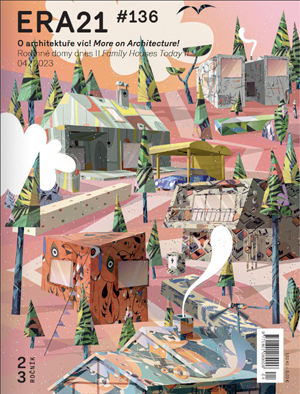Institut pro politiku a společnost a časopis ERA21 zvou na veřejnou debatu Umění v brněnském veřejném prostoru, která se koná v úterý 18. června od 17 hodin v sále č. 6 Místodržitelského paláce Moravské galerie v Brně. Účast v diskuzním panelu přislíbili teoretička a architektka Martina Sedláková, kurátorka a členka pražské komise Programu 2 % na umění Marie Foltýnová, vedoucí oddělení veřejného prostoru Kanceláře architekta města Brna David Zajíček a členka kurátorského týmu Brno Art Open 2019 Marika Kupková. Moderovat budou šéfredaktor ERA21 Filip Landa a historička umění Petra Lexová.
» entire articlePreparing for an interview with three people representing different generational and professional views on architecture wasn’t easy. The male members of the Lasovský family welcomed us in Hřebenky, Prague, where they built a house together (and the entire street, in fact). The oldest one invited us to the table, the middle one brought desserts, and the youngest made coffee. The short interview morphed a passionate, two-hour discussion about the career of an architect of the same name but in different times.
» entire articleV září loňského roku otevřela společnost Renson, belgický výrobce vzduchotechniky, stínění a venkovních pergol, svůj Concept Home u města Waregem. Jedná se o testovací centrum, kde bude možné v reálném prostředí zkoušet a porovnávat jednotlivé produkty i celá řešení. Praktická data budou shromažďována v neobydleném stavu i poté, co se do objektu nastěhují uživatelé.
» entire articleFor a joint debate we invited the representatives of the three generations established in the three decades after 1990. The oldest generation was represented by Michal Kohout who finished his architectural studies before 1989, but founded his studio in the 1990s. The middle generation was represented by Roman Brychta who established his office, Projektil, after 2000. The youngest generation, launching their careers after 2010, was represented by Markéta Mráčková and Ondřej Chybík who personify two different approaches to architecture, a result of the possibilities the profession offers today.
» entire articleRodinný dům v Belgii čekala nejenom přestavba, ale také rozšíření. Noví obyvatelé se rozhodli kompletně rekonstruovat dům po svých rodičích a přistavět nové kancelářské prostory. Nechtěli však zcela ztratit původní tradiční vzhled vesnického domu a podařilo se jim najít střední cestu mezi minimalismem a autenticitou.
» entire article

ERA21 vydává ERA Média, s. r. o. |
|
|
Phone: +420 530 500 801 E-mail: redakce@era21.cz |
|
| WEBdesign Kangaroo group, a.s. |